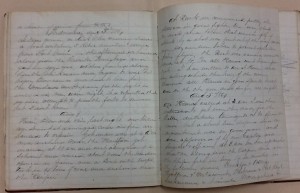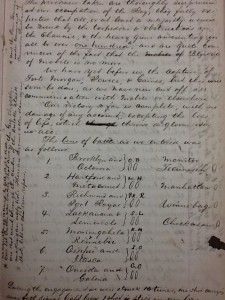By: Kevin Ray, Archival Technician
This week, in honor of the 150th anniversary of the Battle of Mobile Bay, Kevin Ray gives an three-part account of the battle drawn from a combination of secondary sources and two diaries held in the Division of Special Collections. All images are from Ellsworth Hults and Eston C. Lambert’s diaries. Both men belonged to the Union navy. Parts II and III will be posted this Wednesday and next Monday.
In the early morning hours of August 5, 1864, Rear Admiral David Farragut ordered his fleet of United States Navy ships into battle against the Confederate forces defending the entrance to Mobile Bay. This moment was the culmination of two years of planning and anticipation. In April, 1862, Farragut had led the U.S. Navy up the Mississippi River and captured New Orleans. The fall of New Orleans left Mobile, Alabama, as the South’s only major port of entry on the Gulf Coast. Blockade runners, bringing badly need supplies into the South, made use of Mobile. Mobile’s railroad connections added to its strategic importance for the Confederate war effort. Farragut advocated attacking Mobile Bay, and perhaps even the city itself, since the fall of New Orleans. But he had to wait for two years. In Washington, there were always more pressing objectives.
While Farragut waited, Confederate forces around Mobile Bay prepared. A naval invasion of the bay would be difficult under normal conditions. It was shallow, especially at its northern end, and would not accommodate a fleet of large ships. In addition, numerous obstacles had been placed in the bay by the Confederates. More hazardous, however, were the torpedoes. These were mines that had been laid in strategic areas. The entrance was defended by two large forts, along with one smaller fort. Fort Morgan stood at Mobile Point, on the eastern side of the entrance. Fort Gaines, on Dauphin Island, occupied the western side of the entrance. The smaller Fort Powell was on a little island between Dauphin Island and the mainland. The only opening available to an invading navy was a narrow channel to the west of Fort Morgan and to the east of where the torpedoes had been laid.
A small Confederate fleet under the command of Admiral Franklin Buchanan waited in the lower bay, just above the entrance at Mobile Point. The fleet consisted of only four ships. Three of the ships, CSS Selma, CSS Morgan, and CSS Gaines, were small side-wheel gunboats. The remaining ship, CSS Tennessee, was Admiral Buchanan’s flagship and perhaps the most powerful vessel in either navy. Tennessee was a large iron-clad ram, so called because of the iron protrusion at her bow that was used to ram enemy ships. She was heavily armored with iron platting up to six inches thick. In spite of her great power, Tennessee had two serious weaknesses: she was very slow and her steering chains were partly exposed. Still, she could wreak havoc on the Union fleet.
Come back on Wednesday to read what happened next!


